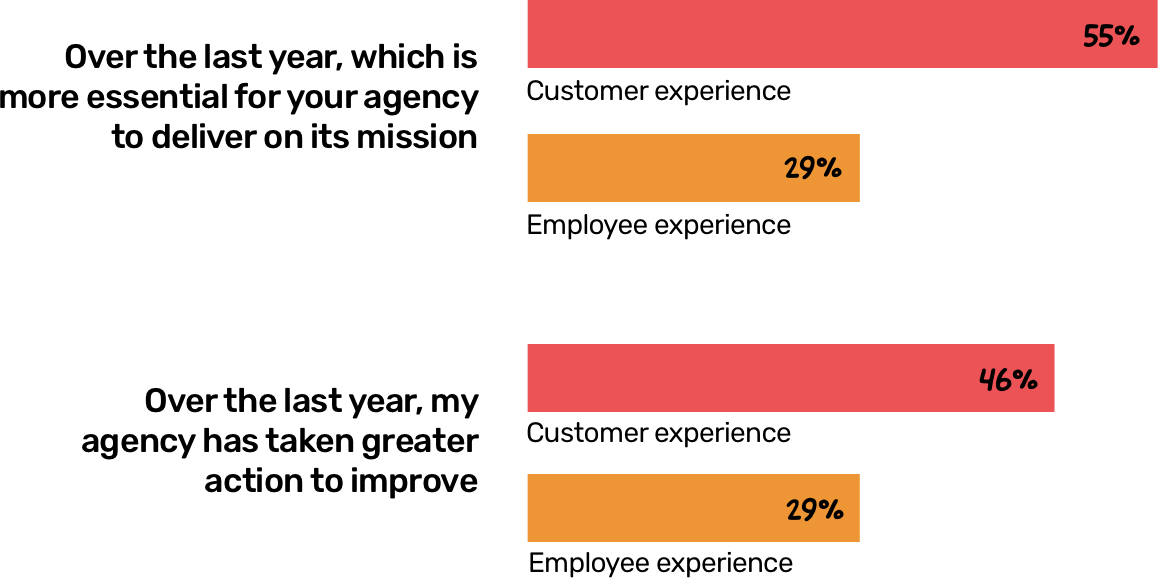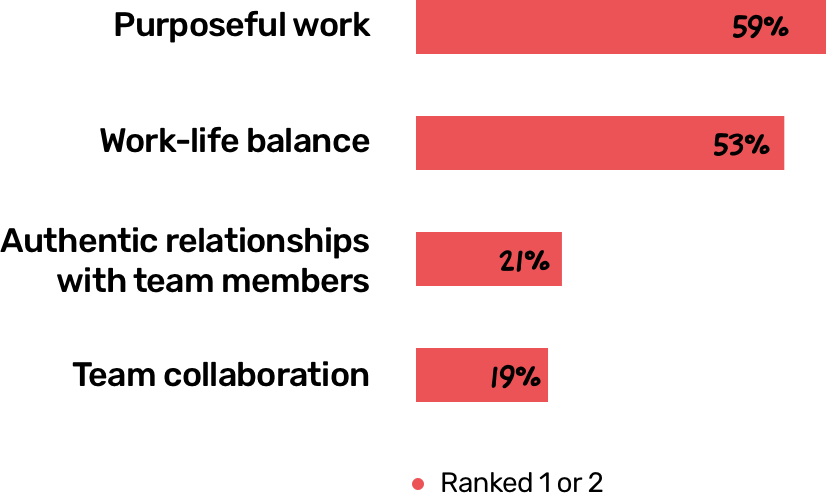Report
Exceptional customer experience in government stems from empowered federal employees

Fifty-one percent of US federal workers say that the employee experience impacts their ability to serve customers. Yet only one third (33%) say that their organization places importance on employee experience/satisfaction, according to a recent survey by Eagle Hill Consulting.
Knowing citizen satisfaction with federal government services is at its lowest point since 2015, Eagle Hill’s survey of 509 federal government employees finds that the relationship between the employee experience and customer service may be the most important, and overlooked, piece in the customer experience puzzle.
A customer service focus alone will not move the federal customer experience needle very far
Eagle Hill’s survey finds agencies have committed to improving the customer experience—and federal employees have noticed.
As shown in Figure 1, federal respondents say their organizations weighted customer experience higher than employee experience when asked which of the two experiences was more essential for their agency to deliver on its mission over the last year (55%), and which of the two experiences their agency has taken greater action to improve over the last year (46%).
Figure 1: Federal employees see disparity in how their agencies prioritize customer experience and employee experience

Source: Eagle Hill Consulting Federal Employee Experience Survey 2020
Organizational investments in customer experience make sense, particularly in an environment where citizen trust in government is at historic lows. As a 2020 World Bank research study explains, “When citizen engagement is designed and implemented well, it provides government an opportunity to foster ‘process-based’ trust in public deliberation and service delivery. While trust may be one determinant for citizens to participate in this process, citizens’ experiences and satisfaction in the process could also shape trust in government.” Undoubtedly, improving federal customer experiences and meeting customer expectations can play an important role in shaping trust in government.
However, the employee experience also has considerable ripple effects on the customer experience, and government should pay attention. The big investments organizations have made for years to improve the customer end of the customer experience—such as enhancing self-service options, enriching websites, and offering greater channel flexibility—do not touch the human relationships that are the real heart of the customer experience. As citizens emerge from the pandemic emotionally battered, they will crave a heightened level of interest and care for their problems that can only come from invested and engaged federal employees.
As citizens emerge from the pandemic emotionally battered, they will crave a heightened level of interest and care for their problems that can only come from invested and engaged federal employees.
The relative neglect of the employee experience plays out as employee frustration in multiple areas, with potential customer experience implications
Right now, 53% of federal employees report being very satisfied with their overall experience working at their agency, with another 39% being somewhat satisfied. Taken together, these numbers are positive. However, Eagle Hill sees an imperative to shore up the numbers, particularly among that second group of employees—the nearly four out of ten with tepid enthusiasm for their current work experience. And while overall, federal employees in our survey report being satisfied, three in ten (29%) disagree that they would stay with their agencies if offered a comparable position elsewhere with similar pay and benefits.
In addition to the potential for employee attrition, Eagle Hill’s findings suggest that agencies’ failure to invest in the employee experience will cause customer service in government to suffer in other ways. According to our survey, a majority of federal respondents agree that their feelings about their day-to-day work experience—negative or positive—impact their productivity (58%).
When employees feel dissatisfied about their experience at work, there is a profound negative impact internally and externally. Our survey found that dissatisfied employees are much more likely than satisfied ones to say their feelings about their day-to-day work experience negatively impact their productivity and their ability to serve customers, and unsatisfied employees are more likely to say they do not deliver quality outcomes (Figure 2).
Figure 2: Negative feelings about the employee experience negatively impact the customer experience
Being productive
My feelings about my day-to-day work experience negatively impact my productivity.

Serving customers
My feelings about my day-to-day work experience negatively impact my ability to serve customers.

Delivering quality outcomes
I deliver quality outcomes.

Source: Eagle Hill Consulting Federal Employee Experience Survey 2020
Interestingly, survey respondents often cited their willingness to help others, including peers, partners and of course, customers, as the area most affected by their feelings about their daily work experience (62%).
The takeaway for agencies is that the relative lack of emphasis on improving the employee experience leads to downstream effects on the citizen. And these negatively impacted customer experiences will be much harder to root out and solve than others. For example, our survey found that employees who say they are dissatisfied with their overall experience at work are much more likely (25% versus 7%) to say that that their feelings about their day-to-day work experience negatively impact their willingness to help others.
While issues of productivity and performance manifest in metrics, the bigger question is how do agencies deal with the thorny root problems of employee attitude and motivation? They do so by developing cultures that support the employee experience, equipping employees to do their jobs with confidence, supporting their career progression, and demonstrating their overall physical and emotional well-being matters to management.
Issues of productivity and performance manifest in metrics. The thorny problems of attitude and motivation are much more difficult to root out and solve.
Weakened team dynamics and remote work affect the ability to jointly serve customers
After a year of solitary working, it is not surprising that employees feel better about their individual contributions than they do about their team dynamics. Introspection, self-reliance, and some surprise at how much they could accomplish outside of the traditional office setting has federal employees feeling very positive about themselves. In fact, our survey found that 98% of federal employees said that they deliver quality outcomes. Similarly, the survey found that 98% say they provide excellent customer service, and 95% agree they are productive at work.
While employees feel good about themselves as individual performers, they feel far less confident in their teammates’ capabilities. For example, in our survey, 46% of respondents cite having to do the work of underperforming colleagues among their top sources of frustration at work.
When asked to reflect on the factors they valued most at work, respondents were much more likely to rank individualistic factors in their top two than they were to rank factors related to teamwork. For example, 59% rated purposeful work as a top factor, followed by work-life balance (53%). In contrast, only 21% of respondents ranked authentic relationships with team members and 19% ranked team collaboration among their top two most valued factors at work (Figure 3).
Figure 3: Employees appear to value individualistic factors more than team-based ones at work
Which factors do you value the most in terms of your day-to-day work experience?

Respondents ranked the factors from 1 to 9 with 1 being the most valuable.
Source: Eagle Hill Consulting Federal Employee Experience Survey 2020
The weaker team dynamics shown in these findings hint at a much larger issue: excellent customer experiences depend on strong and cohesive teams that trust each other. As David De Cremer notes in the article, What COVID-19 Teaches Us About the Importance of Trust at Work, “Trust is important to the functioning of organizations because of its indirect effects. That is, when trust is in place people will act in certain ways and it is those behaviors that will eventually lead to outcomes that drive performance.”
Over the past year, it has become more difficult and complicated for employees to collaborate, innovate, and work together in teams to solve customer problems. Twenty-one percent of respondents in our survey disagree that they feel connected to their colleagues.
As post-COVID working models expand to include more in-person team opportunities, it’s time for managers to strengthen team connections. Right now, one-third of federal workers (34%) in our survey say their manager/supervisor does not demonstrate care/concern about their interactions and relationships with team members. Federal employees already feel good about their work contributions; it is up to management now to pull all the individual islands of excellence back together.
Excellent customer experiences depend on strong cohesive teams.
Technology is one key to better customer experiences, but agencies need to keep employees’ user experience in mind
Total federal IT spending has risen over the past decade, from $75.4 billion in FY11 to $90.9 billion in FY21, but employee attitudes on technology are decidedly mixed. While 69% of federal employees say technology improves their ability to serve customers, 22% say technology actually makes it harder for them to do their work. Overall, more than one third of respondents in our survey (38%) say technology frustrates them.
While the specific technologies that federal employees feel help or hinder them are not obvious, the message about agencies needing to incorporate employee sentiments into their technology development plans (ideally) or their change management plans and communications (at a minimum) comes through very clear.
Overall, more than one third of respondents say technology frustrates them.
Accounting for employee sentiments toward technology becomes even more important as federal agencies gear up for post-COVID return to work. According to FedTech magazine, “Across the federal government, in response to the coronavirus pandemic, IT leaders have been forced to accelerate digital transformation efforts, including digitization of forms and processes and wider deployment of cloud-based collaboration tools to support telework.”
Previous Eagle Hill research found that 36% of employees nationally say the nature of their work has changed due to COVID-19. During the pandemic, employees have felt pulled into work they would not typically do. They have been introduced to a slew of new processes, ways of work, customer interactions—and technologies.
All of these changes underscore the seriousness of properly preparing and supporting federal employees to maintain excellent customer experiences. Right now, with the investments the federal government makes in IT, they need to proactively address the employee perspective. Employees have shown they want to do an excellent job, and Eagle Hill sees the employee experience regarding technology as a significant opportunity for agencies to provide the right support to help their employees succeed.
Given the importance of the employee experience to the customer experience, we recommend the following steps agencies can take to improve both.

Involve federal employees in shaping your customer experience strategy
Probing how employees think and feel about all interactions within their agency and externally with citizens will illuminate challenges, motivations, and opportunities to improve the employee experience. That, in turn, will have positive ripple effects for the customer experience. A diverse cross-section of employees and their first-hand experiences can illuminate unseen gaps in the customer experience and potential remedies.
Beyond the data or hypothetical customer journey maps you may have developed, think through all touchpoints across the employee experience with a customer focus, and explore whether those touchpoints cause an employee distress or call for greater support based on their impact. What is the intersection with the employee experience? For example, do employees need their roles more clearly defined; do they have the right technology and training to serve customers; are they surrounded by high-functioning teams? The answers to these questions should help guide future investments.
A diverse cross-section of employees and their first-hand experiences can illuminate unseen gaps in the customer experience and potential remedies.

Emphasize group cohesion
How employees support one another in the workplace, both in their day-to-day work and in other aspects of their lives, contributes to an environment where employees feel comfortable bringing their whole selves to work and engaging with their peers. Previous federal research from Eagle Hill found that federal employees view team leads/managers and teammates as the most important influencers in driving change at the workplace. Inspire these groups to create a culture that supports and respects the individual. Build social belonging through affinity groups, offsite working sessions, and team outings (virtual or in-person) and communicate frequently about team expectations and changes, then give employees control over how teams operate.

Show all employees that what they do has a meaningful impact on customer outcomes
Nearly all federal employees we surveyed (97%) state they are dedicated to achieving their agency’s mission. In fact, our survey found that a majority of federal employees (59%) rank purposeful work (passion for mission) among the top two factors impacting their work day-to-day experience.
In their employees’ desire to serve the public, agencies have an incredible, inherent engine of customer experience excellence. To tap into it, agencies should link all employee roles to one another, which will then lead to citizen impact. For example, an employee responsible for HR programs supports employee growth and motivation, which ultimately affects their ability to serve citizens better. An employee in IT creates and implements technologies that make a difference in how effective their colleagues can be in serving the citizen.

Establish what the agency’s customer experience vision looks like in action
Without agency guidance, few employees make the explicit connection between customer experience vision statements (aspirational end states) and the tactical actions and behaviors they can take to contribute. Break down the vision statement into the specific values all employees should hold to create an exceptional customer experience and corresponding actions and sample behaviors. Getting all employees on the same page about what the customer vision looks like in practice is the starting point of individual and team accountability.
Without agency guidance, few employees make the explicit connection between vision statements and the tactical actions and behaviors they can take to improve customer experience.

Tie employee metrics to customer metrics
Pulse surveys, biannual surveys, and regular feedback sessions with employees can all help organizations better understand and empathize with the employee viewpoint. Agencies should begin with an assessment to get a baseline of employee attitudes, followed by an ongoing feedback loop that directs future adjustments in strategy.
As agencies review their employee data, they should then analyze key customer experience/employee experience performance indicators side-by-side in a joint dashboard. Shifts on the employee experience side (such as employee satisfaction and turnover) often act as leading indicators for performance on the customer experience side (such as customer satisfaction).
Methodology
The Eagle Hill Consulting Federal Employee Experience Survey 2020 was conducted online by Greenwald Research in December 2020. The online survey included 509 respondents from federal employees across the United States. The survey polled respondents on aspects of their employee experience with technology.

